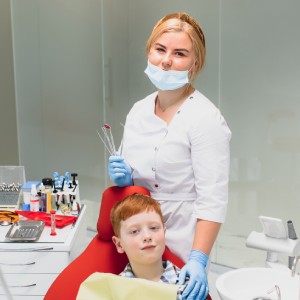
Every parent dreams of seeing their child grow up with a confident, healthy smile. But did you know that early orthodontic care plays a vital role in shaping that smile? Knowing when to start orthodontics and dentistry can make a significant difference in your child’s oral development, helping prevent complex dental issues later in life. Early detection allows the orthodontist to guide jaw growth, ensure proper tooth alignment, and maintain healthy bite function — all before major problems arise.
In our previous blog, we discussed the best guidelines to ensure healthy teeth growth in children. In this blog, we will go through the stages and signs that indicate that children must undergo an orthodontic evaluation.
So, how do you know when it’s the right time for your child to see a specialist? Here are five important stages or signs by age that indicate an orthodontic evaluation might be necessary.
At this stage, children’s baby teeth play a crucial role in setting the foundation for adult teeth. While their adorable grins may look perfect, subtle signs can signal early orthodontic needs.
Key signs to watch for:
Although it may seem early, a visit to the dentist at this age can help detect jaw growth problems and prevent misalignment before the emergence of permanent teeth.
This is the time when baby teeth start falling out and permanent teeth begin to appear. Orthodontists often call this the “mixed dentition” stage, and it’s one of the best times for an initial orthodontic assessment.
Signs your child may need an evaluation:
An early evaluation from an orthodontist in Monrovia helps identify whether your child may benefit from interceptive orthodontics — simple treatments that guide teeth into better alignment as they grow.
As your child’s facial structure develops, you may start noticing more visible changes in their bite and smile. This is also the ideal age range for phase-one orthodontic treatment if it’s needed.
Look for these warning signs:
Addressing these issues early prevents severe misalignment and reduces the need for extractions or complex treatment later. Regular visits to the dentist can help monitor these changes and catch concerns early.
By this stage, most permanent teeth have erupted, and it’s typically when braces or aligners are introduced. Growth spurts also make this an ideal time to correct jaw alignment and spacing.
Watch for these indicators:
At this age, orthodontic treatments from a dentist near you in Monrovia are more efficient since the jawbone is still developing, allowing for smoother adjustments and faster results.
As teenagers grow older, final orthodontic evaluations help ensure that earlier treatments have been successful or determine if minor refinements are needed.
Potential signs for further evaluation:
These years are critical for maintaining results and ensuring long-term dental stability. Regular checkups and retainers play a major role in preserving that perfect smile.
Recognizing when to start orthodontic care is one of the best things you can do for your child’s oral health. By understanding the key stages and signs, you can make informed decisions that set the stage for a lifetime of healthy smiles. If you’re wondering when to schedule your child’s first evaluation, don’t wait — visit a trusted dentistry in Monrovia today to ensure their smile grows beautifully and naturally. Call now at 626-445-6666!
Video Coming Soon...
Accessibility Menu